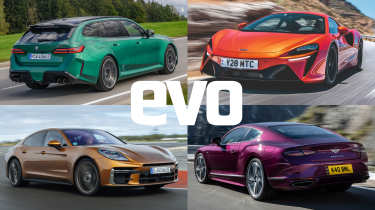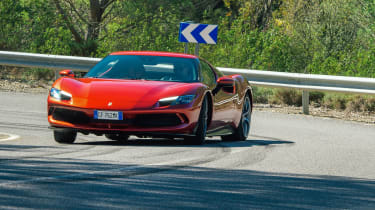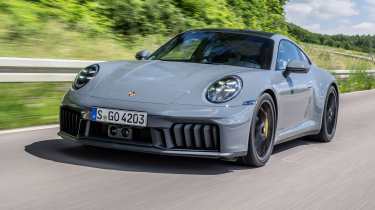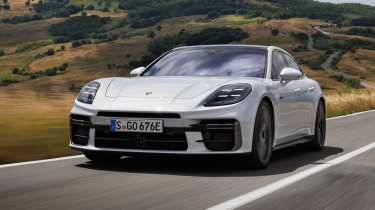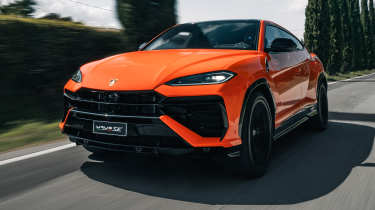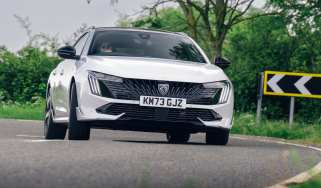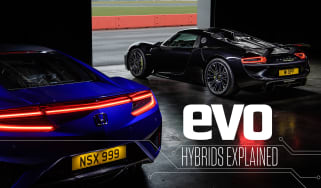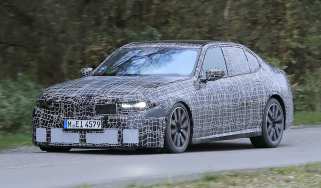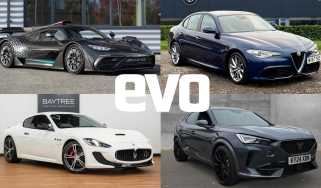Best hybrid cars 2025 – the best of both worlds
Fast and furious on the right roads, silent and sensible when you want them to be. From supersaloons to supercars, these are our favourite hybrid performance cars
In what is the most volatile new car landscape we’ve seen in generations, the power of the consumer has been made abundantly clear. As EV uptake has stalled, conversely, the popularity of hybrids has exploded, to the point that manufacturers have been forced to backtrack or diversify their offerings, bolstering their lineups with PHEV stepping stones. Hybrids are everywhere with almost no exceptions, with the numbers of electrified cars that would appeal to evo readers jumping up massively too, from supercars and SUVs to supersaloons.
Of course, the so-called holy trinity of hybrid hypercars – the McLaren P1, Ferrari LaFerrari and Porsche 918 Spyder – effectively introduced hybridisation to the world of performance cars over a decade ago. Even in those ultra-exclusive and ultra-focused hypercars, the potential benefits of part-electrification were obvious. Never mind torque fill, the ability to drive on electric power and leave your house in the morning without an anti-social cold start was always going to be a game changer. Not that the buyers of those cars were your average nine-to-five commuters, but the potential utility was clear to see. And so over a decade on, there’s a full-bodied lineup of hybrid premium and performance cars on the market, to the point that you could fill an entire issue of evo with them. Here are some of the very best.
Best hybrid cars 2025
- BMW M5
- Bentley Continental GT Speed
- Ferrari 296 GTB
- McLaren Artura
- Porsche 911 GTS T-Hybrid
- Porsche Panamera Turbo E-Hybrid
- Chevrolet Corvette E-Ray
- Lamborghini Urus SE
- Mercedes-Benz C300e
BMW M5
The big hybrid of the moment, so to speak, is the BMW M5. It weighs a colossal 700kg more than its pure-V8 predecessor, and you have to wonder whether that’s a worthy trade-off for an extra 100bhp or so and 42 miles of electric driving. But in our first drives of both the saloon and the new M5 Touring, we found that BMW has engineered the c2.5-ton G90 to drive with remarkable precision and agility for its size. It really doesn’t feel as heavy as it is.
The biggest problem is that you don’t feel much, full stop. The new car doesn't grab you by the soul like the old M5 CS did, editor-at-large John Barker summing it up by saying ‘I admire it more than desire it.’ With that said, the M5 is a blisteringly effective and well engineered piece of machinery and should not be dismissed out of hand on account of its less than flattering weight figure.
Bentley Continental GT Speed
You have to wonder why the BMW M5 gets such a hard time for weighing what it does, when the new hybridised Bentley Continental GT Speed is just as heavy. Perhaps it’s because Bentleys have always been more concerned about luxury than pure athleticism, making the leap to a heavier PHEV less controversial. But again, while the Bentley’s c2.5 ton kerb weight might jump off the screen at you, it would be totally unfair to dismiss it on that basis.
Because like the M5, the GT Speed is a mighty impressive achievement, in the way it manages its weight and in terms of its pace – not surprising when it has 771bhp and 738lb ft of torque. In fact, thanks to its new electronically-controlled two-chamber air suspension, torque vectoring capability and limited-slip differential, the heaviest Continental GT yet is also one of the most dynamic. It’s still a proper Bentley too, with the presence, refinement, quality and appointment you’d expect, only now with the ability to drive electrically, in actual silence, for up to 50 miles.
> Bentley Continental GT Speed review
Ferrari 296 GTB
Never one to rest on its laurels, Ferrari wasted no time getting its second series-production hybrid on the road in the form of the 296 GTB. It is slightly less complicated than the V8-powered SF90, coming without the two front-mounted electric motors, and uses this purer connection between the powertrain and control to great effect.
The V6 itself is worth a mention, too, as not only is it the most powerful V6 in production right now (without the hybrid additions, that is), but there’s also a real sense of drama and theatricality that belies its meagre cylinder count. But even more impressive, and it might just be colloquial, is that this V6 feels like it was designed from its inception to work with its allotted hybrid module, rather than a simple drop-in power unit borrowed from elsewhere in the range.
McLaren Artura
The Artura is McLaren’s first series-production hybrid. It mimics the Ferrari’s basic hybrid system, pairing a new wide-angle V6 engine to an electric motor that powers the rear wheels via a dual-clutch transmission. Over the years the Artura has been updated to refine the package and boost its initial 671bhp power figure to 690bhp. It’s still below that of the 296 GTB, which produces as much as 819bhp in its most potent driver mode, but that variation is drawn almost entirely from the engine, rather than the electric motor.
Apart from being hybrids, there are key differences between the two, starting with the McLaren’s brakes. The Ferrari, like most hybrids, uses regenerative braking to help refill the battery pack and recycle some of the otherwise wasted energy. McLaren on the other hand has kept the braking purely by means of pad and disc, making the brake pedal feel even more impressive than the Ferrari’s. In fact, this emphasis on ‘feel’ rather than outright performance is seen in various parts of the Artura, as not only are the brakes non-regenerative, they’re also still fully cable operated rather than by-wire as almost all new cars are. The same can be said of its hydraulic steering, with the whole package being one of the most organic-feeling hybrid cars we’ve yet driven. It’s also the most impressive hybrid of its type for electric range, offering 19 miles of silent running capability.
Porsche 911 GTS T-Hybrid
This 911 GTS T-Hybrid probably has the least claim to a place on this list, given it has no electric-only driving capability. The electrified element is instead fully integrated into the powertrain as a performance enhancer that happens to help reduce emissions. Incorporating a small electric motor into its eight-speed PDK transmission, the 992.2 GTS has a relatively measly 1.9kWh battery – just over one fiftieth the size of the largest Taycan battery. The battery also feeds an electric motor that’s connected to the 3.6-litre engine’s single turbo, allowing it to be pre-spooled for quicker response. Both motors work together to effectively eliminate turbo lag and together with the internal combustion engine, generate 534bhp and 450lb ft of torque.
It’s not the outright power that’s impressive, though, it’s how deeply well-resolved this car feels. In spite of it being the most experimental 992 yet, it also feels the most complete. An unconventional hybrid it may be, but it’s symbolic of how electric power can be integrated with the combustion engines we know and love, enhancing performance with few – if any – downsides.
> Porsche 911 GTS T-Hybrid review
Porsche Panamera Turbo S E-Hybrid
Porsche’s hybrid Panamera has evolved into a force of nature in its latest Turbo S E-Hybrid form. With M5-beating levels of power and ultra-sophisticated active suspension tech, it’s one of the most advanced supersaloons on sale today.
For the latest Turbo S E-Hybrid, Porsche has tweaked elements such as the blending of the powertrain’s petrol and electric motors, and better integrated the PDK transmission. It’s also made big improvements to brake pedal feel and the switch between regenerative and friction braking. With 771bhp this comfortable, cossetting, luxurious and well-equipped supersaloon will hit 62mph in 2.9sec before reaching 202mph (which it does so with remarkable ease on the autobahn). When not flat out, it’ll go an impressive 52 miles on a charge thanks to its 25.9kWh battery.
The new car also gets Porsche’s Active Ride suspension system, which employs active dampers controlled by electro-hydraulic pumps to keep the body as level as possible. It can effectively stamp out body roll.
Chevrolet Corvette E-Ray
Beating Porsche to the punch, Chevrolet has also integrated electrified powertrain tech into its Corvette sports car. The E-Ray is the result, with a 1.9kWh battery feeding a motor on the front axle and allowing for a low single-figure electric driving range. Pointless? Not entirely, if you’re bimbling in traffic or wanting to make a whisper-quiet getaway in the morning. But at the same time, that electric motor also adds to the LT2 small block’s 495bhp, for a 655bhp total output, allowing it to reach 62mph in under three seconds.
It also isn’t too heavy, weighing just over 100kg more than the Z06. In theory, it’s the ultimate all-rounder Corvette. In practice, well, we’d need to spend a little more time with it but the concept and initial impressions are very promising indeed.
> Chevrolet Corvette E-Ray review
Lamborghini Urus SE
Revuelto, Temerario, Urus SE – yes, the full Lamborghini lineup is electrified. We found the original Urus to be a bit rough around the edges, and not in the endearing, charming, ‘Lamborghini’ way. The Urus SE, which on top of being easier on the eye, brings hybridisation for 789bhp, electric-only driving capability and a handy helping of sophistication.
Thanks to its 25.9kWh battery and 37 miles of claimed electric range, it boasts impressive versatility that even Ferrari Purosangue buyers will be envious of when sitting with that V12 chuntering away in traffic. Is it the most charming or engaging of its ilk? That’s where the Purosangue and the Aston Martin DBX707 claw back some ground but there’s no doubting the real world appeal of the Lambo. Is that a sentence that’s ever been written before?
Mercedes-Benz C300e
Mercedes has had a rough go of it in the press lately with how its C63 E Performance has been received – its absence is notable on this list. But there’s a dark horse in the C-Class family that does deserve to be celebrated, the C300e. Because it’s not a performance variant, it carries a different set of expectations than the C63, with all-round usability mattering much more than driving thrills. It has a healthy 25.4kWh battery, allowing for an official electric driving range of over 70 miles, yet in spite of its hybrid tech, it’s priced from a reasonable £49,860.
If you’re genuinely interested in going all electric but can’t quite fit an EV into your life, the Merc really is a credible alternative to the likes of the Tesla Model 3. You could argue that the C300e is one of the most important hybrids on this list, because it’s the best at being a stepping stone towards our impending EV future.
